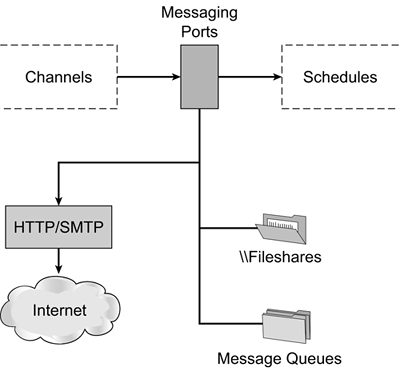BizTalk Concepts
| < Day Day Up > |
| BizTalk is Microsoft's entry into the EAI market. As with Microsoft's general approach to computing, BizTalk is designed to dramatically decrease the cost and time required to field EAI solutions and to automate processes that were formerly painstakingly performed by hand. This goal is accomplished by abstracting the process and developing software components that handle each step in an automated transaction. BizTalk provides an integration platform that shields developers from the harsh world of communications protocols, data formats, and API details. It is based on the open standards of the Internet including HTTP, XML, SOAP, XSLT, and MIME. BizTalk supports both a loosely coupled asynchronous communications environment and a high-performance, optimized synchronous interface model. Asynchronous communications are preferred when poor network connectivity and a low number of transactions are present, while a synchronous approach often makes sense inside a corporate network with a predictably high volume of transactions. For instance, integrating dozens or hundreds of suppliers might call for the asynchronous approach, while connecting the factory to the shipping dock might lend itself better to synchronous communications. BizTalk accepts messages with documents, and then processes them and sends them to the appropriate place (Figure 11.9). First, the incoming document is copied into BizTalk and then parsed and converted to XML (if it is not already an XML document). The source specification is a schema for the data model of the incoming document. It is created by the developer using the BizTalk Editor. Figure 11.9. BizTalk Document Processing (Source: Microsoft, "Using EDI with BizTalk Server 2002," February 2002.) Next, the incoming document is mapped to the data schema, using the Extensible Stylesheet Language Transformation (XSLT) map. This mapping is created with the BizTalk Mapper. From this schema, the serializer converts data to the destination document format. Once again, the BizTalk Editor is the tool for creating the destination specification. BizTalk parsers and serializers can translate XML, EDI (X12 and EDIFACT), and flat files (delimited and fixed length). While this transformation is at the heart of BizTalk, it has other components that manage the messaging traffic, orchestrate the transactions, and handle all other required functions. The BizTalk paradigm encompasses the following key elements: adapters, channels, and messaging ports. AdaptersBizTalk adapters are software components that link an application to BizTalk. The adapter provides two-way communication with BizTalk. It also defines the metadata and communicates changes to the metadata to BizTalk Server. The adapter is used for setup and maintenance of the interface between an application and BizTalk. As of this writing, there were more than 300 adapters available from Microsoft and third parties at www.microsoft.com/biztalk/evaluation/adapters/adapters.asp. If your company uses SAP for its manufacturing operations and PeopleSoft for human resources, for instance, you could use these adapters to make the systems talk to one another. Third-party vendors often certify the BizTalk adapters so you can be confident that they will be effective with your software installation. ChannelsChannels are dedicated to the processing of a particular type of incoming document. A channel is like an assembly line that is tailored to produce a certain product (Figure 11.10). The transaction is recorded in the log. The channel transforms the data, mapping the source to the destination using the XML schema. If the document is encrypted or digitally signed, the channel handles these functions. Figure 11.10. BizTalk Channels (Note: Directional arrows denote flow of data.) Channels allow complex business processes to be broken down into manageable pieces that can be developed and maintained independently. A channel consists of functions and objects. Messaging PortsIn all BizTalk implementations , messages are used as the means to move data from one system to another. These messages must be fast and reliable. A message contains the elements listed in Table 11.4. Table 11.4. Elements of a BizTalk Message (Source: Adapted from Microsoft, "Adapter Developers' Guide White Paper," at www.microsoft.com/downloads/details.aspx?FamilyId=0F74B087-675E-4C8B-9921-49C986E345DC&displaylang=en.)
Messaging ports are invoked by channels according to the business process described in the XLANG schedule. They can receive messages through multiple protocols, but most commonly HTTP is the protocol of choice (Figure 11.11). Figure 11.11. BizTalk Messaging Ports BizTalk adapters automatically build messages for you. BizTalk Server monitors the messages as they move from one system to another. You can monitor the status of each message and visualize how your integration is working. |
| < Day Day Up > |
EAN: 2147483647
Pages: 164


